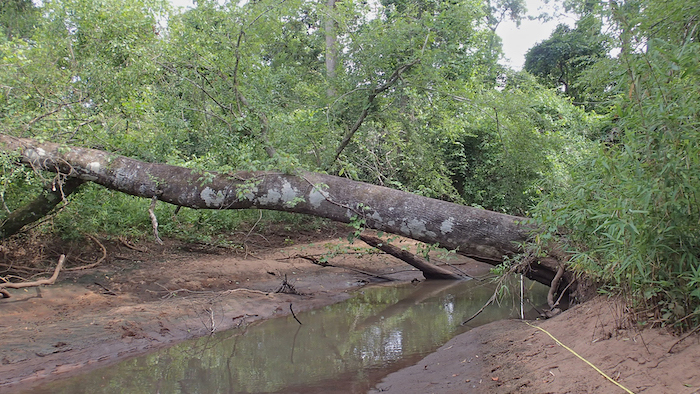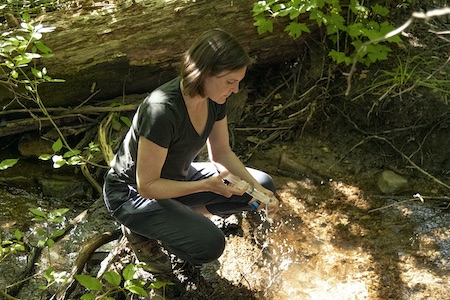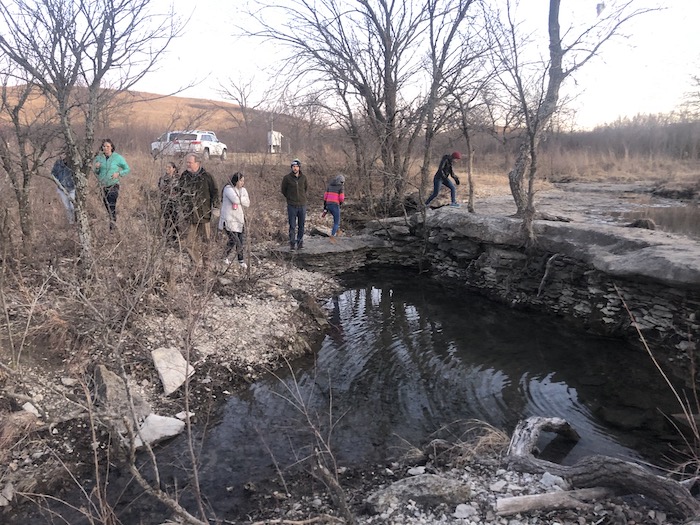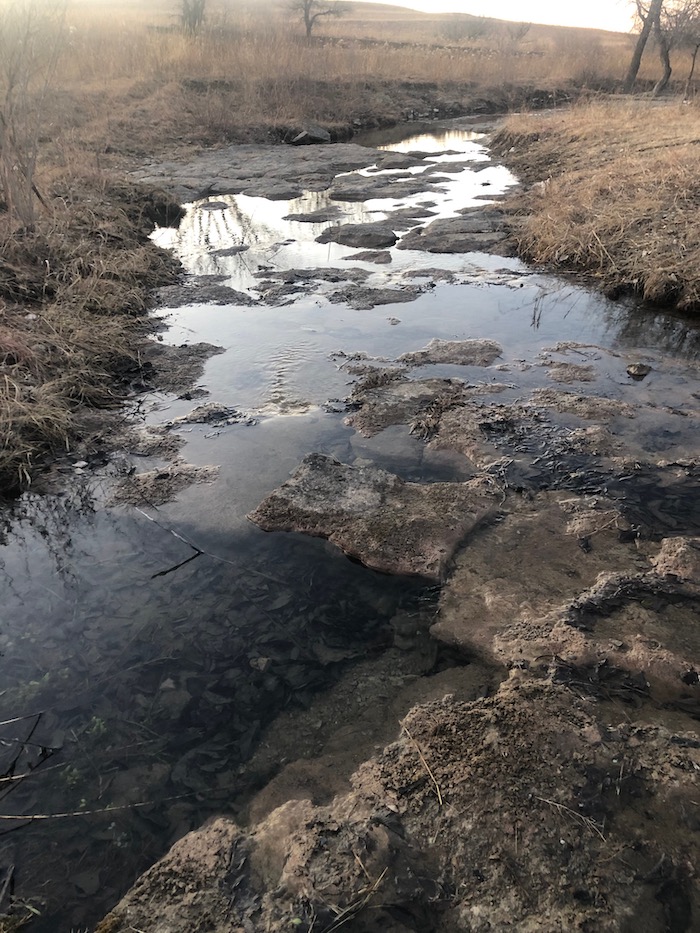Ambitious project spanning 5 states, 8 institutions will focus on intermittent streams

LAWRENCE — A major new research project headquartered at the University of Kansas will investigate how intermittent streams — the half of the world’s streams that flow only part of the year — support both the environment and humankind.
 Intermittent streams move carbon and nutrients while controlling water quality through hydrology, chemistry and microbial activity. Yet, they’ve remained little-studied — until now.
Intermittent streams move carbon and nutrients while controlling water quality through hydrology, chemistry and microbial activity. Yet, they’ve remained little-studied — until now.
The work, funded by a $6 million, four-year National Science Foundation EPSCoR Track 2 grant, comprises 18 investigators at eight institutions. In an effort dubbed the Aquatic Intermittency effects on Microbiomes in Streams (AIMS) project, the researchers plan to install new sensors and field sites, train a dozen graduate students and numerous undergraduates in team-science approaches, train 36 new instructors in teaching data science methods, and boost workforce development and education. The work will also inform sometimes thorny policy and legal debates.
 “I’m really excited about the team we’ve pulled together to study intermittent streams — we’ve got aquatic ecologists, hydrologists, microbiologists, data scientists — all from many institutions around the country,” said lead principal investigator Amy Burgin, associate professor of ecology & evolutionary biology and environmental studies at KU and associate scientist with the Kansas Biological Survey. “Intermittent streams are everywhere — in Kansas, we know this because we see even larger rivers go dry as you drive across the state on I-70. Our estimate using public data is that around half of the stream miles statewide only flow intermittently.”
“I’m really excited about the team we’ve pulled together to study intermittent streams — we’ve got aquatic ecologists, hydrologists, microbiologists, data scientists — all from many institutions around the country,” said lead principal investigator Amy Burgin, associate professor of ecology & evolutionary biology and environmental studies at KU and associate scientist with the Kansas Biological Survey. “Intermittent streams are everywhere — in Kansas, we know this because we see even larger rivers go dry as you drive across the state on I-70. Our estimate using public data is that around half of the stream miles statewide only flow intermittently.”
At KU, Burgin’s key collaborators are Sam Zipper and Erin Seybold, assistant scientists at the Kansas Geological Survey; Jamene Brooks-Kieffer, associate librarian and data services librarian & coordinator of digital scholarship with KU Libraries; and Jay Johnson, professor and associate chair of geography & atmospheric science and liaison with Haskell Indian Nations University.
 According to Burgin, a comprehensive scientific assessment of intermittent streams worldwide is overdue, and it will inform science, policy and law in the U.S.
According to Burgin, a comprehensive scientific assessment of intermittent streams worldwide is overdue, and it will inform science, policy and law in the U.S.
“Intermittent streams are common in all biomes and are potentially important controls on water quality,” she said. “However, we lack data, infrastructure, training and methods to properly study them. Thus, we find it difficult to predict their influence on water quality. Understanding their role in influencing water quality is at the heart of the policy debate regarding changes to the Waters of the U.S. Rule. Thus, our work will be important to inform national policy conversations.”
Burgin said the funding from NSF-EPSCoR will help build a collaborative “dream team” to better study intermittent streams. The effort grew out of a different NSF-funded project, a Research Coordination Network on DryRivers.
“The DryRivers RCN group met up for the first time last fall in New Mexico,” she said. “One of our goals was to synthesize existing data and literature around stream intermittency, microbes and water quality; however, it didn’t take us long to figure out that it would be hard to do because of the relative lack of data and studies available to synthesize. That gave us a strong justification to write a proposal to fund the work we will do on the AIMS project.”
Burgin’s collaborators in three regions of study across the U.S. will help to create a network of instrumented field sites designed to generate “big data” to quantify flow intermittency, microbiome structure and activity, and biogeochemical processes.
“At the University of Alabama, we’re excited to incorporate intermittent streams into our river ecosystem research program,” said primary investigator Carla Atkinson, associate professor of biological sciences at UA. “Alabama is home to a wide range of important water resources. As the state transitions from Appalachia to coastal lowlands, our rivers and streams support one of the most diverse aquatic ecosystems in the world. This project will examine how connectivity between terrestrial and aquatic systems impacts downstream water quality and ecosystem integrity. Our work in the southeast region will engage a diverse group of students, including undergraduates at Alabama A&M, an HBCU. We’re particularly excited to see how our regional analysis in the southeast U.S. compares to work being conducted across the broad geographic scale that the AIMS project encompasses, while also engaging a diversity of researchers across career stages.”
More fieldwork will take place in the Mountain West, where Sarah Godsey, associate professor of geosciences at Idaho State, will oversee research into intermittent streams that flow from mountains.
“This project will allow us to study one of the most sensitive aspects of water supplies in the western mountains — snowpacks in headwater basins,” Godsey said. “It’s often said that mountains are the water towers of the west, and often they help bridge the gap through dry summer months by slowly releasing meltwaters that keep streams and rivers flowing. But if more rain falls instead of snow, that can lead to less reliable flows and more stream drying — and we may not have the same water quality that we’re used to. This project will help us understand patterns of drying and water quality in western mountain streams that sometimes have snow in winter and sometimes have rain. In addition, it will support three graduate students, three undergraduate students and a postdoctoral scholar. Students from the Shoshone-Bannock tribes will also have the opportunity to travel with a tribal elder to visit Haskell Indian Nations University and connect with tribal members who are Haskell alumni.”
Other collaborators, based on the Great Plains, are Josh Meisel of Haskell, Lydia Zeglin of Kansas State University and Daniel Allen of the University of Oklahoma. In the Southeastern U.S., investigators are Atkinson, Jonathan Benstead and C. Nathan Jones of the University of Alabama, Kevin Kuehn of the University of Southern Mississippi and Colin Jackson of the University of Mississippi. Collaborators in the Mountain West are Godsey, Rebecca Hale, Kathleen Lohse, Ken Aho and Yaqi You at Idaho State University.
Their research results could help resolve difficulties defining ecological connections between perennial and intermittent streams that lie at the heart of an ongoing policy debate over legal protection of isolated water bodies, as recently demonstrated by the late 2019 repeal of the 2015 Waters of the U.S. Rule. The researchers said the infrastructure installation planned under the AIMS project is designed to confront these difficulties head-on.
Further, the AIMS Undergraduate Program (AIMS UP) will recruit two students per summer from regional partners, such as HINU, Alabama A&M and the Shoshone-Bannock Summer Youth Program (SBSYP). One facet of the training will boost use of data-science tools and big data, a key AIMS goal, accomplished by “On Ramps to Data Science,” an implementation of The Carpentries teaching materials and instruction practices intended to increase data-science training in each jurisdiction.
“AIMS will allow KU to expand its existing institutional membership in The Carpentries," said Brooks-Kieffer, who coordinates Carpentries activities at KU. "Additional data-intensive classes at HINU will be developed, as well as sensor modules for use by all partner educational programs. We will use this expansion to train and certify personnel at each site as Carpentries instructors. In addition, AIMS affiliates will learn from our experiences at KU about creating and sustaining local instructor cohorts, as well as planning and hosting learning opportunities.”
These initiatives will link to the Haskell Environmental Research Studies program, which prepares Native students for graduate study. By training scientists to use cutting-edge tools and big data, AIMS will build capacity vital to a modern, well-educated workforce.
Top photo: Intermittent streams like this one move carbon and nutrients while controlling water quality through hydrology, chemistry and microbial activity. Yet, they’ve remained little studied. Credit: Amy Burgin
Top right photo: Co-principal investigator Rebecca Hale taking water samples at a small Idaho stream. Credit: Eric Gordon
Middle right photo: Members of Amy Burgin's research group at Konza in January 2020 on a field trip to think about proposed grant work on intermittent streams. Credit: Amy Burgin
Bottom right photo: A potential field site in Alabama. Credit: Carla Atkinson.